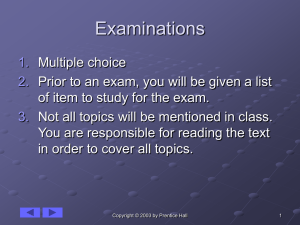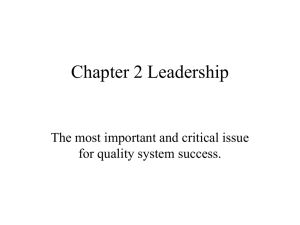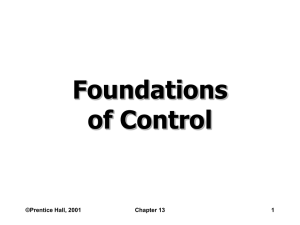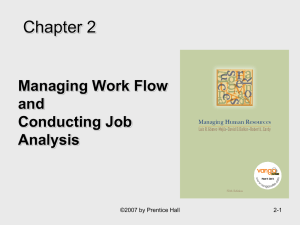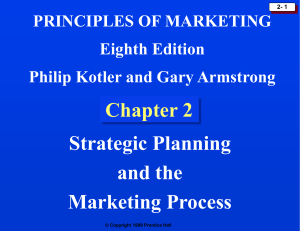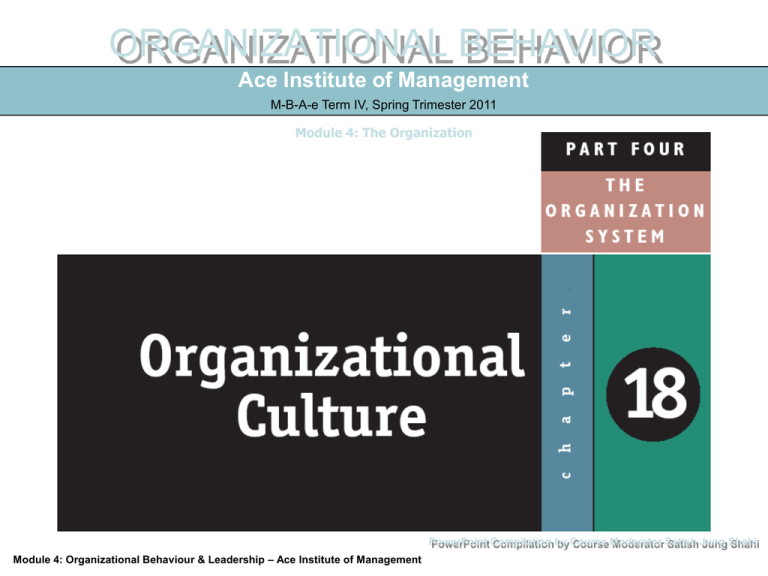
ORGANIZATIONAL BEHAVIOR
Ace Institute of Management
M-B-A-e Term IV, Spring Trimester 2011
Module 4: The Organization
PowerPoint Compilation by Course Moderator Satish Jung Shahi
Module 4: Organizational Behaviour & Leadership – Ace Institute of Management
Institutionalization: A Forerunner of Culture
© 2003 Prentice Hall Inc. All rights reserved.
18–2
What Is Organizational Culture?
Characteristics:
1. Innovation and risk
taking
2. Attention to detail
3. Outcome orientation
4. People orientation
5. Team orientation
6. Aggressiveness
7. Stability
© 2003 Prentice Hall Inc. All rights reserved.
18–3
What Is Organizational Culture? (cont’d)
© 2003 Prentice Hall Inc. All rights reserved.
18–4
What Is Organizational Culture? (cont’d)
© 2003 Prentice Hall Inc. All rights reserved.
18–5
What Is Organizational Culture? (cont’d)
Culture Versus Formalization
– A strong culture increases behavioral consistency and
can act as a substitute for formalization.
Organizational Culture Versus National Culture
– National culture has a greater impact on employees
than does their organization’s culture.
– Nationals selected to work for foreign companies may
be atypical of the local/native population.
© 2003 Prentice Hall Inc. All rights reserved.
18–6
What Do Cultures Do?
Culture’s Functions:
1. Defines the boundary between one
organization and others.
2. Conveys a sense of identity for its members.
3. Facilitates the generation of commitment to
something larger than self-interest.
4. Enhances the stability of the social system.
© 2003 Prentice Hall Inc. All rights reserved.
18–7
What Do Cultures Do?
Culture as a Liability:
1. Barrier to change
2. Barrier to diversity
3. Barrier to acquisitions and
mergers
© 2003 Prentice Hall Inc. All rights reserved.
18–8
Keeping Culture Alive
Selection
– Concerned with how well the candidates will fit into the
organization.
– Provides information to candidates about the
organization.
Top Management
– Senior executives help establish behavioral norms that
are adopted by the organization.
Socialization
– The process that helps new employees adapt to the
organization’s culture.
© 2003 Prentice Hall Inc. All rights reserved.
18–9
Stages in the Socialization Process
© 2003 Prentice Hall Inc. All rights reserved.
18–10
A Socialization Model
EXHIBIT
© 2003 Prentice Hall Inc. All rights reserved.
18-2
18–11
Entry Socialization Options
• Formal versus Informal
• Individual versus Collective
• Fixed versus Variable
• Serial versus Random
• Investiture versus Divestiture
EXHIBIT
© 2003 Prentice Hall Inc. All rights reserved.
18-3
18–12
How Organization Cultures Form
EXHIBIT
© 2003 Prentice Hall Inc. All rights reserved.
18-4
18–13
How Employees Learn Culture
• Stories
• Rituals
• Material Symbols
• Language
© 2003 Prentice Hall Inc. All rights reserved.
18–14
Creating An Ethical Organizational Culture
Characteristics of Organizations that Develop
High Ethical Standards
– High tolerance for risk
– Low to moderate in aggressiveness
– Focus on means as well as outcomes
Managerial Practices Promoting an Ethical
Culture
–
–
–
–
Being a visible role model.
Communicating ethical expectations.
Providing ethical training.
Visibly rewarding ethical acts and punishing unethical
ones.
© 2003 Prentice Hall Inc. All rights reserved.
18–15
Creating a Customer-Responsive Culture
Key Variables Shaping Customer-Responsive
Cultures
1. The types of employees hired by the organization.
2. Low formalization: the freedom to meet customer
service requirements.
3. Empowering employees with decision-making
discretion to please the customer.
4. Good listening skills to understand customer
messages.
5. Role clarity that allows service employees to act as
“boundary spanners.”
6. Employees who engage in organizational citizenship
behaviors.
© 2003 Prentice Hall Inc. All rights reserved.
18–16
Creating a Customer-Responsive Culture
Managerial Actions:
• Select new employees with personality and
attitudes consistent with high service
orientation.
• Train and socialize current employees to be
more customer focused.
• Change organizational structure to give
employees more control.
• Empower employees to make decision about
their jobs.
© 2003 Prentice Hall Inc. All rights reserved.
18–17
Creating a Customer-Responsive Culture
Managerial Actions (cont’d) :
• Lead by conveying a customer-focused vision
and demonstrating commitment to customers.
• Conduct performance appraisals based on
customer-focused employee behaviors.
• Provide ongoing recognition for employees who
make special efforts to please customers.
© 2003 Prentice Hall Inc. All rights reserved.
18–18
Spirituality and Organizational Culture
Characteristics:
• Strong sense of
purpose
• Focus on individual
development
• Trust and openness
• Employee
empowerment
• Toleration of employee
expression
© 2003 Prentice Hall Inc. All rights reserved.
18–19
How Organizational Cultures Have an Impact
on Performance and Satisfaction
EXHIBIT
© 2003 Prentice Hall Inc. All rights reserved.
18-7
18–20
Wrapping-Up Organizational Culture:
Imagine:
We run the management of Yeti Airlines in Nepal. We have
made a strategic alliance with Air Arabia and extended our
services along the international air route – the license for
which was pending with us due to financial crunch despite
permission from the Government of Nepal two years ago. As
per this alliance, we will be conducting KTM-KUL-KTM direct
flights along the Nepal-Malaysia air route. We need to send
one of our collegues as our Station Manager in Kualalumpur,
Malaysia. Let us choose that colleague and advise him/her
about the new workplace.
© 2003 Prentice Hall Inc. All rights reserved
ORGANIZATIONAL BEHAVIOR
Ace Institute of Management
M-B-A -e Term IV, Spring Trimester 2011
Module 4: The Organization
PowerPoint Compilation by Course Moderator Satish Jung Shahi
Module 4 : Organizational Behaviour & Leadership – Ace Institute of Management
Forces for Change
EXHIBIT
© 2003 Prentice Hall Inc. All rights reserved.MBAe OB
Fall 2008, Module 4 – Ace Institute of Management
19-1a
19–23
Forces for Change (cont’d)
EXHIBIT
© 2003 Prentice Hall Inc. All rights reserved.MBAe OB
Fall 2008, Module 4 – Ace Institute of Management
19-1b
19–24
Managing Planned Change
Goals of Planned
Change:
Improving the ability of
the organization to adapt
to changes in its
environment.
Changing the behavior of
individuals and groups in
the organization.
© 2003 Prentice Hall Inc. All rights reserved.MBAe OB
Fall 2008, Module 4 – Ace Institute of Management
19–25
Resistance to Change
Forms of Resistance to Change
– Overt and immediate
• Voicing complaints, engaging in job actions
– Implicit and deferred
• Loss of employee loyalty and motivation, increased
errors or mistakes, increased absenteeism
© 2003 Prentice Hall Inc. All rights reserved.MBAe OB
Fall 2008, Module 4 – Ace Institute of Management
19–26
Sources of Individual Resistance to Change
EXHIBIT
© 2003 Prentice Hall Inc. All rights reserved.MBAe OB
Fall 2008, Module 4 – Ace Institute of Management
19-2
19–27
Sources of Organizational Resistance to
Change
EXHIBIT
© 2003 Prentice Hall Inc. All rights reserved.MBAe OB
Fall 2008, Module 4 – Ace Institute of Management
19-40
19–28
Overcoming Resistance to Change
Tactics for dealing with resistance
to change:
• Education and communication
• Participation
• Facilitation and support
• Negotiation
• Manipulation and cooptation
• Coercion
© 2003 Prentice Hall Inc. All rights reserved.MBAe OB
Fall 2008, Module 4 – Ace Institute of Management
19–29
Lewin’s Three-Step Change Model
© 2003 Prentice Hall Inc. All rights reserved.MBAe OB
Fall 2008, Module 4 – Ace Institute of Management
19–30
Lewin’s Three-Step Change Model
EXHIBIT
© 2003 Prentice Hall Inc. All rights reserved.MBAe OB
Fall 2008, Module 4 – Ace Institute of Management
19-5
19–31
Unfreezing the Status Quo
EXHIBIT
© 2003 Prentice Hall Inc. All rights reserved.MBAe OB
Fall 2008, Module 4 – Ace Institute of Management
19-6
19–32
Contemporary Change Issues for Today’s
Managers: Stimulating Innovation
Sources of Innovation:
• Structural variables
• Organic structures
• Long-tenured
management
• Slack resources
• Interunit
communication
• Organization’s culture
• Human resources
© 2003 Prentice Hall Inc. All rights reserved.MBAe OB
Fall 2008, Module 4 – Ace Institute of Management
19–33
Contemporary Change Issues for Today’s
Managers: Creating a Learning Organization
Characteristics:
1. Holds a shared vision
2. Discards old ways of
thinking.
3. Views organization as
system of relationships.
4. Communicates openly.
5. Works together to
achieve shared vision.
© 2003 Prentice Hall Inc. All rights reserved.MBAe OB
Fall 2008, Module 4 – Ace Institute of Management
19–34
Contemporary Change Issues for Today’s
Managers: Knowledge Management (KM)
Why KM is important:
Intellectual assets are as
important as physical
assets.
When individuals leave,
their knowledge and
experience goes with
them.
A KM system reduces
redundancy and makes
the organization more
efficient.
© 2003 Prentice Hall Inc. All rights reserved.MBAe OB
Fall 2008, Module 4 – Ace Institute of Management
19–35
Contemporary Change Issues for Today’s
Managers: Culture-Bound Organizations
Questions for culture-bound organizations:
1. Do people believe change is even possible?
2. How long will it take to bring about change in the
organization?
3. Is resistance to change greater in this organization due
to the culture of the society in which it operates?
4. How will the societal culture affect efforts to implement
change?
5. How will idea champions in this organization go about
gathering support for innovation efforts?
© 2003 Prentice Hall Inc. All rights reserved.MBAe OB
Fall 2008, Module 4 – Ace Institute of Management
19–36
Additional: Theories of “Learning”
1) Classical Conditioning.
- Grew out of experiments to teach dogs to
salivate in response to the ringing of a bell, Ivan
Pavlov.
- Involves the creation of unconditioned stimulus
that creates unconditioned response. Learning a
conditioned response involves building up an
association between a conditioned stimulus and
an unconditioned stimulus.
- E.g.: Malshree Dhun often brings pleasant
memories of the festive season.
© 2003 Prentice Hall Inc. All rights reserved.MBAe OB
Fall 2008, Module 4 – Ace Institute of Management
19–37
Additional: Theories of “Learning” (…cont.)
2) Operant Conditioning.
- Behavior is a function of its consequences.
- People learn to behave to get something they
want or to avoid something they don’t want.
- It involves voluntary or learned behavior in
contrast to reflexive or unlearned behavior.
- Brought about by B. F. Skinner.
- E.g.: You tend to work overtime if your boss
assures and implements his commitment to
compensate you in your next performance
appraisal.
© 2003 Prentice Hall Inc. All rights reserved.MBAe OB
Fall 2008, Module 4 – Ace Institute of Management
19–38
Additional: Theories of “Learning” (…cont.)
3) Social Learning.
- Individuals can learn by observing what
happens to other people and just by being told
about something, as well as by direct
experiences.
- Extension of operant conditioning, but also
acknowledges the existence of observational
learning and the importance of perception in
learning.
- Processes: Attention; Retention; Motor
Reproduction; and, Reinforcement.
END
© 2003 Prentice Hall Inc. All rights reserved.MBAe OB
Fall 2008, Module 4 – Ace Institute of Management
19–39
Case Study:
“Pack Your Bags, You’ve Been Transferred to Kenya”
You have to read this case and answer at least two
questions given at the end of the case. Your
submission deadline is within this class. This is the
final of the seven case studies you have dealt so far.
Only top five marks will be considered for your final
grading. Each case is worth 6/100 for your final
grading.
N0TE: NEXT CLASS IS YOUR FINAL FOR THIS MODULE
THIS SEMESTER AND WILL INCLUDE YOUR FINAL
GROUP PRESENTATIONS!
© 2003 Prentice Hall Inc. All rights reserved


